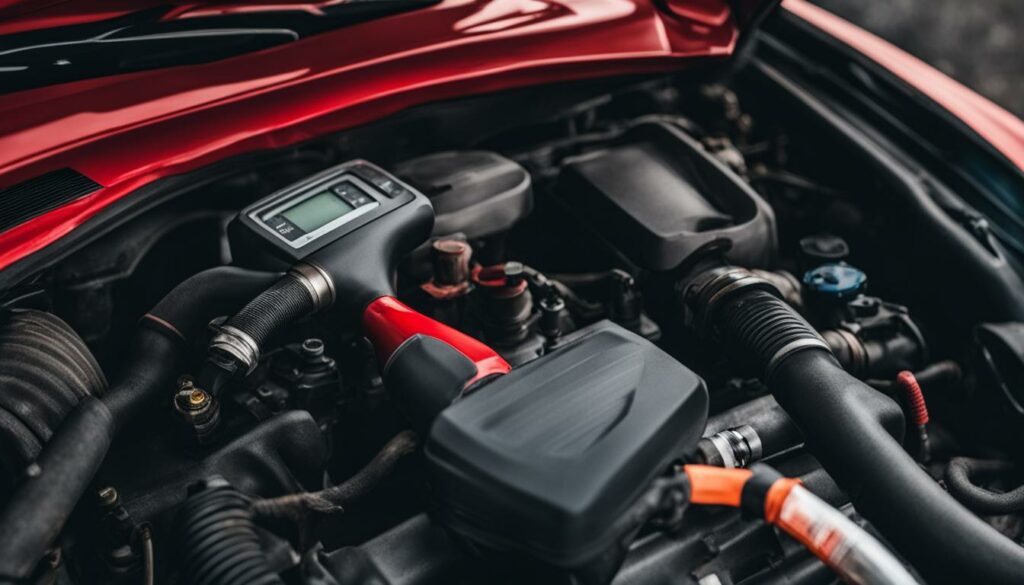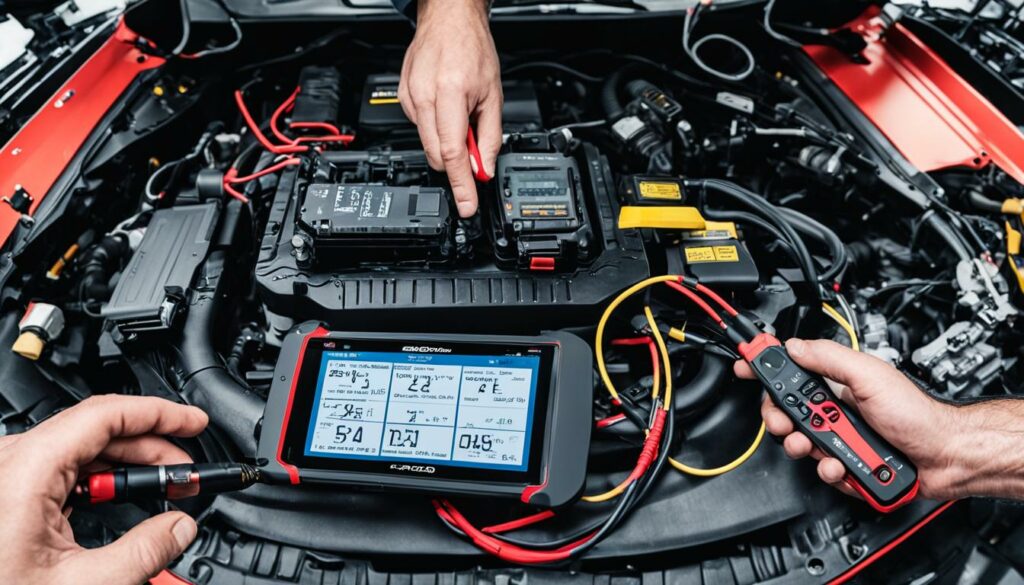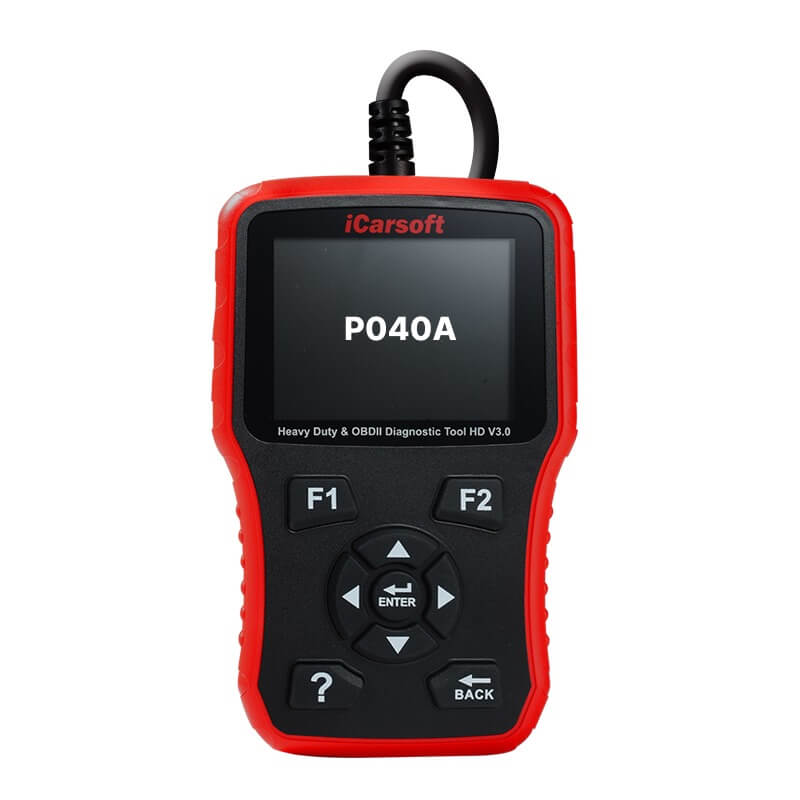P040A – Exhaust Gas Recirculation Temperature Sensor “A” Circuit
POSTED IN pcodes
Welcome to our informative article on the P040A diagnostic trouble code! In this section, we will explore the technical description, meaning, severity, symptoms, common causes, troubleshooting steps, and repair options related to the P040A code.
The P040A code specifically relates to a fault in the Exhaust Gas Recirculation (EGR) Temperature Sensor “A” Circuit. The EGR system is an important component in your vehicle’s engine, responsible for reducing vehicle emissions and improving engine performance. The EGR temperature sensor plays a vital role in monitoring the temperature within the EGR system, allowing for proper adjustment of the flow of exhaust gases. This is essential for efficient fuel combustion and compliance with emission standards.
A fault in the EGR temperature sensor circuit can result in various symptoms, such as failed emissions tests, engine noise, louder exhaust than usual, and excessive exhaust smells. It is crucial to address these symptoms promptly to maintain optimal engine performance and reduce vehicle emissions.
Some common causes of the P040A code include a defective or damaged EGR temperature sensor, a leaking gasket, a cracked or leaking exhaust pipe, faulty wiring, or issues with the Engine Control Module (ECM). Troubleshooting steps typically involve a visual inspection of the sensor and the EGR system, cleaning if necessary, and verifying the integrity of the sensor through electrical measurements using a multimeter.
If professional assistance is not available or desired, there is an alternative solution to permanently remove the P040A code by modifying the Engine Control Unit (ECU) file. However, it is important to proceed with caution and consult with a qualified technician or seek professional advice before attempting any modifications to your vehicle’s ECU.
Buy tested tuning file for Adblue / EGR / DPF / Adblue off now!
Key Takeaways:
- The P040A code indicates a fault in the EGR Temperature Sensor “A” Circuit.
- The EGR system plays a vital role in reducing vehicle emissions and improving engine performance.
- Faulty EGR temperature sensor circuit can lead to symptoms such as failed emissions tests, engine noise, and excessive exhaust smells.
- Common causes of the P040A code include a defective or damaged sensor, leaking gasket, cracked exhaust pipe, faulty wiring, or ECM issues.
- Troubleshooting steps may involve visual inspection, cleaning the EGR system, and verifying the sensor’s integrity.
Understanding the Significance of the P040A Code
The P040A code is a diagnostic trouble code (DTC) that signifies a malfunction in the EGR Temperature Sensor “A” Circuit. The EGR system plays a vital role in reducing vehicle emissions and enhancing engine performance. By recirculating exhaust gases, it facilitates more efficient fuel combustion and reduces the release of harmful pollutants into the atmosphere.
The EGR temperature sensor is a crucial component of the EGR system as it monitors the temperature within the system and allows the engine control module (ECM) to adjust the flow accordingly. When a fault occurs in the EGR temperature sensor or its circuit, it can negatively impact the performance of the EGR system and potentially lead to increased emissions or engine issues.
Understanding the significance of the P040A code is essential for maintaining optimal engine performance and minimizing vehicle emissions. Diagnosing and addressing the underlying issue promptly will ensure that your vehicle operates efficiently and complies with emission regulations.
For a more detailed explanation and insights into the significance of the P040A code, refer to the following table:
| Code | Significance |
|---|---|
| P040A | Indicates a malfunction in the EGR Temperature Sensor “A” Circuit. |
| EGR System | Reduces vehicle emissions and improves engine performance by recirculating exhaust gases. |
| Engine Performance | Optimal engine performance is achieved through efficient fuel combustion and emission control. |
| Vehicle Emissions | Minimizing the release of harmful pollutants into the atmosphere. |
By understanding the significance of the P040A code, you can take appropriate measures to resolve the issue and ensure your vehicle operates at its best. In the next section, we will explore the symptoms associated with the P040A code, helping you identify if your vehicle is experiencing any related issues.
Symptoms of a P040A Code
When your vehicle triggers a P040A code, there are several symptoms that can indicate this issue. It’s important to recognize these symptoms to address the problem promptly and ensure compliance with emission regulations.
- Failed Emissions or Smog Tests: If your vehicle fails an emissions or smog test, it may be an indication of a P040A code. The fault in the EGR Temperature Sensor “A” Circuit can affect your vehicle’s emissions, causing it to exceed allowable limits.
- Engine Noise: A knocking or rattling noise coming from your engine can be a sign of a P040A code. The malfunction in the EGR system can disrupt the proper combustion process, leading to unusual engine sounds.
- Louder Exhaust Than Usual: If you notice that your vehicle’s exhaust is louder than normal, it could be a symptom of a P040A code. The fault in the EGR system can cause increased pressure or altered flow, resulting in a louder exhaust sound.
- Excessive Exhaust Smells: Another symptom of a P040A code is the presence of strong or unusual exhaust smells. The malfunction in the EGR system can lead to improper combustion or incomplete burning of fuel, resulting in abnormal exhaust odors.
If you experience any of these symptoms, it is essential to have your vehicle diagnosed and repaired by a qualified technician. Ignoring these signs can lead to further engine issues and may result in non-compliance with emission regulations.

Common Causes of a P040A Code
When encountering a P040A code, several common causes could be responsible for triggering this diagnostic trouble code (DTC). Understanding these causes can help you identify and address the underlying issue effectively.
EGR Temperature Sensor
One of the primary culprits behind a P040A code is a defective or damaged EGR temperature sensor. This sensor is responsible for monitoring the temperature within the EGR system. Any discrepancy or malfunction in the sensor can disrupt the proper functioning of the circuit.
Gasket Leaking
A leaking gasket around the EGR temperature sensor can also lead to a P040A code. This leakage can result in inaccurate temperature readings and affect the EGR system’s performance.
Cracked or Leaking Exhaust Pipe
If the EGR temperature sensor is mounted on a cracked or leaking exhaust pipe, it can introduce false temperature measurements and trigger the P040A code.
Faulty Wiring Harness or Damaged Wires
A faulty wiring harness or damaged wires connected to the EGR temperature sensor can disrupt the signal transmission and cause the P040A code to appear.
Connection Issues with ECM
A damaged connector or problems with the Engine Control Module (ECM) can also contribute to the P040A code. An unstable connection between the sensor and the ECM can interfere with data transfer and trigger the code.
Addressing these common causes promptly is essential to rectify the issue and restore optimal engine performance. By resolving any defects or malfunctions related to the EGR temperature sensor, gasket, exhaust pipe, wiring harness, or ECM, you can eliminate the P040A code and ensure the proper functioning of your vehicle’s EGR system.
Troubleshooting Steps for a P040A Code
When dealing with a P040A code, there are several troubleshooting steps you can follow to identify and resolve the issue. By performing a visual inspection, cleaning the EGR system, and checking the sensor’s integrity, you can effectively diagnose and address the problem.
1. Visual Inspection
Start by visually inspecting the EGR temperature sensor and its surroundings. Look for any signs of exhaust leaks or damage to the sensor or its wiring harness. As high temperatures can cause wear and tear on the wires, pay close attention to any potential issues in this area.
Additionally, examine the EGR system for accumulated soot or debris that may be affecting its performance. Use a wire brush and a suitable cleaner to remove excess soot from the sensor and other relevant areas to ensure optimal functionality.
2. Cleaning the EGR System
If you notice significant buildup of soot or other contaminants in the EGR system, it may be necessary to clean it thoroughly. Use a suitable EGR system cleaner and follow the instructions provided by the manufacturer to ensure proper usage.
Regular cleaning of the EGR system can help prevent blockages and ensure efficient recirculation of exhaust gases, ultimately optimizing engine performance and reducing emissions.
3. Sensor Integrity Verification
After performing the visual inspection and cleaning the EGR system, it is important to verify the integrity of the EGR temperature sensor. Using a multimeter, measure the electrical values produced by the sensor and compare them to the desired values specified by the manufacturer.
If the measured values deviate significantly from the manufacturer’s specifications, it may be an indication of a faulty sensor that needs replacement. Ensure that the new sensor meets the necessary standards and is compatible with your vehicle’s make and model.
Consulting a vehicle-specific repair manual can provide you with detailed instructions and specifications, enabling you to troubleshoot the P040A code accurately and efficiently.

| Step | Description |
|---|---|
| 1 | Perform a visual inspection of the EGR temperature sensor and its surroundings for exhaust leaks and damage. |
| 2 | Clean the EGR system using a suitable cleaner to remove excess soot and debris. |
| 3 | Verify the integrity of the EGR temperature sensor by measuring its electrical values with a multimeter and comparing them to the manufacturer’s specifications. |
Professional Assistance for P040A Code
If professional assistance is unavailable or if you prefer an alternative solution, there is an option to permanently remove the P040A code. This involves uploading your Engine Control Unit (ECU) file to a specialized portal or service provider. The ECU file will be modified to disable the EGR temperature sensor circuit, effectively eliminating the code. However, it is important to note that this solution may not be suitable for all vehicles and should be approached with caution. It is recommended to consult with a qualified technician or seek professional advice before attempting any modifications to your vehicle’s ECU.
<!–
| Column 1 | Column 2 |
|---|---|
| Data 1 | Data 2 |
–>
Conclusion
In conclusion, the P040A code signifies a fault in the Exhaust Gas Recirculation (EGR) Temperature Sensor “A” Circuit. The EGR system is pivotal in reducing vehicle emissions and enhancing engine performance. An issue with the EGR temperature sensor or its circuit can lead to various symptoms and should be addressed promptly to maintain optimal vehicle operation.
Common causes of the P040A code include a defective sensor, a leaking gasket, or damaged wiring. To diagnose and resolve the issue, troubleshooting steps may involve visual inspection, cleaning the EGR system, and verifying the integrity of the sensor. It is crucial to undertake these steps diligently to ensure precise fault detection and appropriate repairs.
If professional assistance is unavailable, there is an alternative solution of permanently removing the P040A code by modifying the Engine Control Unit (ECU) file. However, it is vital to exercise caution and seek expert advice before attempting any ECU modifications. By addressing the P040A code promptly, you can ensure optimal vehicle performance and contribute to reducing vehicle emissions for a cleaner environment.
FAQ
What does the P040A code mean?
The P040A code refers to a fault in the Exhaust Gas Recirculation (EGR) Temperature Sensor “A” Circuit. It indicates a malfunction in the sensor or its circuit.
What is the importance of the EGR system?
The EGR system plays a crucial role in reducing vehicle emissions and improving engine performance by recirculating exhaust gases back into the combustion process.
What are the symptoms of a P040A code?
Symptoms of a P040A code may include failed emissions tests, engine noise such as knocking or rattling, louder exhaust than usual, and excessive exhaust smells.
What are the common causes of a P040A code?
Common causes of a P040A code include a defective or damaged EGR temperature sensor, a leaking gasket around the sensor, a cracked or leaking exhaust pipe, faulty wiring, or ECM issues.
What are the troubleshooting steps for a P040A code?
Troubleshooting steps for a P040A code may involve performing a visual inspection, checking for exhaust leaks, cleaning the EGR system, and verifying the integrity of the sensor.
Is professional assistance available for a P040A code?
Yes, professional assistance is available for diagnosing and repairing a P040A code. There may also be an alternative solution involving modifying the Engine Control Unit (ECU) file to disable the EGR temperature sensor circuit.


